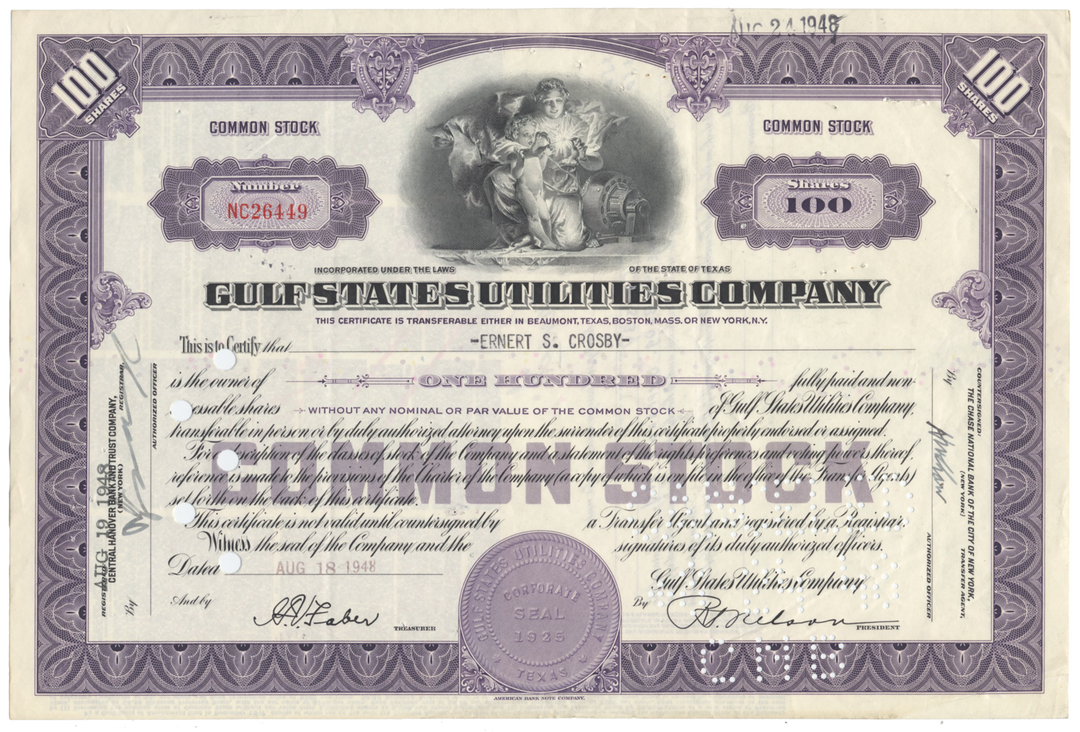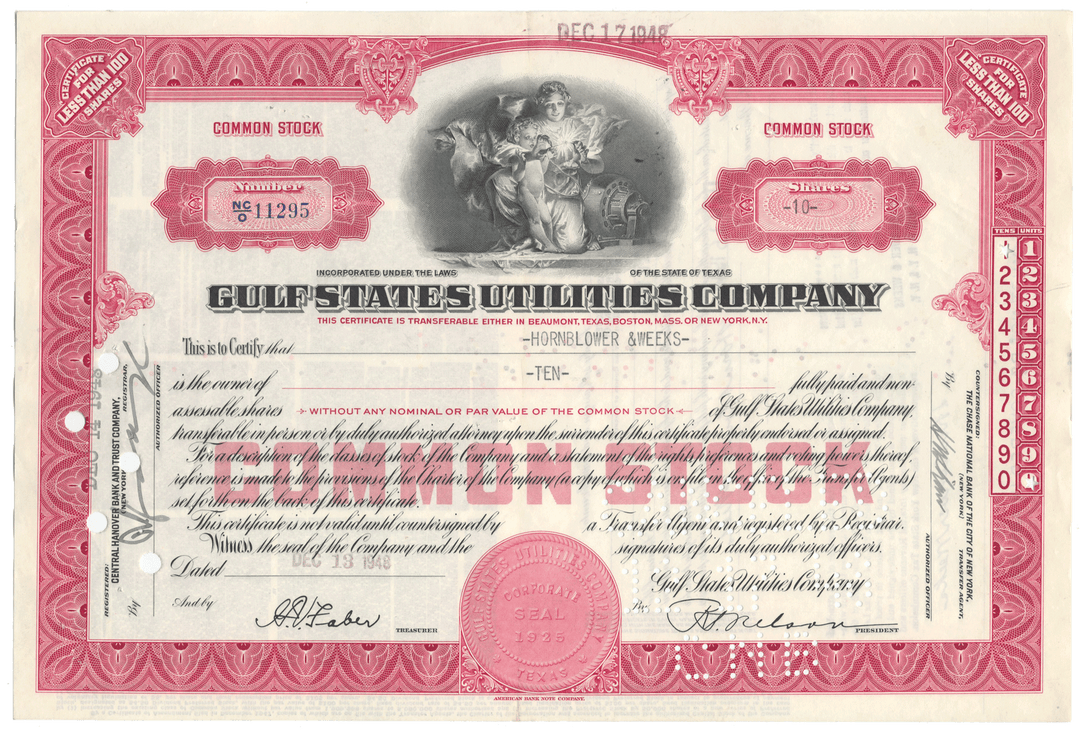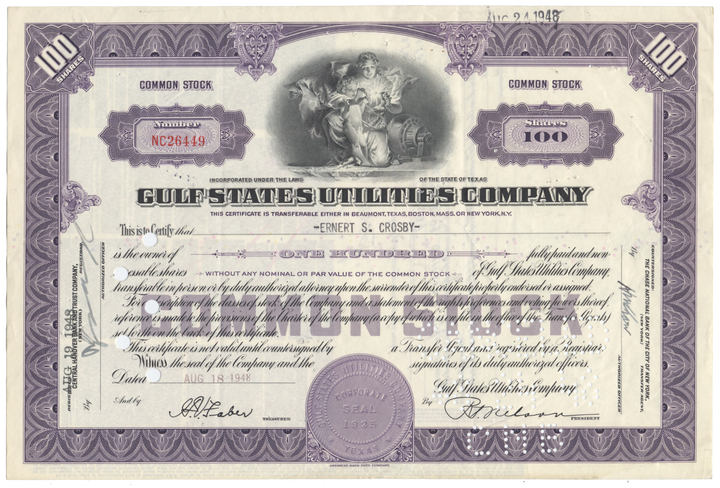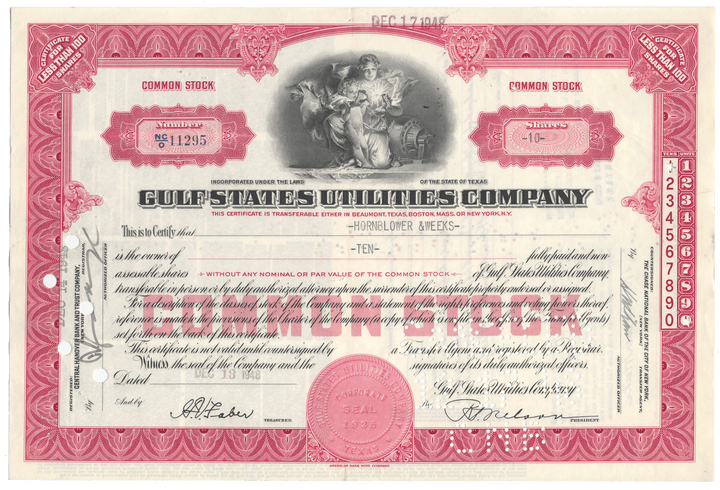Gulf States Utilities Company
- Guaranteed authentic document
- Orders over $75 ship FREE to U. S. addresses
Images are representative of the piece you will receive
Over 50 years old
Common stock
1940's
Issued, canceled
American Bank Note Company
Machine printed signatures
12" (w) by 8" (h)
NA
Historical Context
During the late 1800s, many power companies served Southeast Texas and South Louisiana. Some failed and others were merged into larger units and holding companies, where the pooled resources of the myriad of small operators translated into greater strength.
In 1888 one of Gulf State Utilities’ corporate ancestors, Beaumont Ice, Light and Refrigeration Company, did just about everything for the cattle and lumber town of 3,000. The company sold electricity and ice, furnished water, and even ran a meat market. At about the same time in Baton Rouge, local businessmen formed the Baton Rouge Electric Light and Power Company. Like its counterpart in Beaumont Baton Rouge Electric was a diversified business that by the turn of the century had bought several small companies. In 1890, the company changed owners and became the Baton Rouge Electric and Gas Company.
A holding company formed during that time, Eastern Texas Electric (under the control of the Boston engineering firm Stone & Webster), eventually led to the creation of GSU. A series of mergers and acquisitions of various ice, water, gas, and transportation properties culminated on August 25, 1925, in the incorporation of a single company - Gulf States Utilities - charged with the task of providing electricity, gas, water, and ice to the public.
In general, there were three years in which major acquisitions occurred to form the basis of the GSU service area of today. In 1926, Louisiana Electric Company and Eastern Texas Electric were brought into GSU and with them such properties as Jennings Utilities and Lake Charles Electric Company in Louisiana and the ice, water, and light utilities of Beaumont, Port Arthur, and Silsbee in Texas.
The next major expansion brought in Western Public Service in 1929, which included the area in Texas that now makes up the bulk of GSU's pre-merger Western Division, including the cities of Conroe, Navasota, Cleveland, Huntsville, Liberty, and Dayton. The final major expansion occurred in 1938, when the eastern part of the Louisiana service territory was formed by a merger of GSU with its sister companies, the Baton Rouge Electric Company and the Louisiana Steam Generating Corporation.
Other isolated acquisitions during 1925-1938 added to the fast-growing GSU system, which now served an area that at one time had been served by more than 60 different power companies. Plant and facility investments grew steadily with the increased demand for utility services in a growing geographic area. The petroleum-related industries of the region, spurred by the huge Spindletop oil strike in 1901, created a ready and increasing market for electricity. Firms that depended on the timber, cotton, sugar cane, salt, and sulphur resources of the area also increased the demand for reliable electric service.
Neches Station near Beaumont was constructed soon after incorporation to serve as a major generation source at one end of the system. Louisiana Station was acquired in the 1938 acquisitions, followed by construction of additional generating plants in load centers of the system: Roy S. Nelson Station near Lake Charles and Willow Glen Station south of Baton Rouge went into service in 1960, Sabine Station near Port Arthur in 1962, Lewis Creek Station near the city of Conroe in 1970, and Nelson Coal near Lake Charles in 1982.
In the latter part of the 1970s, GSU entered the age of nuclear power with the start of construction on River Bend Station. GSU's 940 MW boiling water reactor put power into the GSU transmission and distribution system for the first time in December 1985, The unit was declared to be in commercial operation in June 1986.
Related Collections
Additional Information
Certificates carry no value on any of today's financial indexes and no transfer of ownership is implied. All items offered are collectible in nature only. So, you can frame them, but you can't cash them in!
All of our pieces are original - we do not sell reproductions. If you ever find out that one of our pieces is not authentic, you may return it for a full refund of the purchase price and any associated shipping charges.









